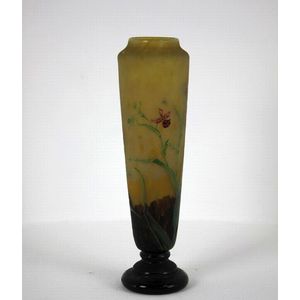French Silver Christening Set with Matching Knife and Spoon
You must be a subscriber, and be logged in to view price and dealer details.
Subscribe Now to view actual auction price for this item
When you subscribe, you have the option of setting the currency in which to display prices to $Au, $US, $NZ or Stg.
- Frieze - An architectural term denoting the flat, shaped or convex horizontal surface of furniture, between the architrave and the cornice, usually found on a cabinet or bookcase, or on desks and tables where it may include drawers, the area between the top and the legs. In ceramics, the term refers to the banding, of usually a repeating pattern, on the rims of plates and vases.
- Foliate - Decorated with leaves or leaf-like forms.
- Engine Turned - Engine turning is a decorative technique used on metal surfaces to create intricate curving or geometric pattern. The process involves cutting a series of lines into the surface of the metal using a rose engine or decoration lathe which rotates the metal as it cuts, allowing the operator to create a repeating pattern that covers the entire surface. The resulting surface has a shimmering, reflective quality that is often described as "engine turned." Where an engine turned item has been enamelled, the term used to describe the decoration is usually guilloche.
Engine turning was originally developed to decorate metal objects such as firearms, scientific instruments, and other metal objects that required precise and elegant design. - Marrow Spoon - A spoon with a long handle and a narrow scoop shaped bowl, used to scoop and eat marrow from the hollow centre of roasted bones. Some marrow scoops are double ended with a different shaped bowl at each end.
This item has been included into following indexes:
Visually similar items

A Daum Nancy acid etched cameo and enamelled glass vase, circa 1900. Baluster form on a circular base, the mottled yellow ground enamelled with red Columbine flower and green stems, acid etched Daum Nancy. 31 cm high.

A Le Verre Francais 'Cardamine' vase, French, circa 1925, the tapering baluster body with an acid-etched design, overlaid in orange and burgundy glass, on a mottled yellow and orange ground, acid etched 'Le Verre Fran?ais, 52 cm high. Provenance: James R.

English hallmarked sterling silver Victorian 'East Kent Hunt officer's cup 1892' having a round straight-sided body with tapering sides, hand-chased work with half-swirl fluted decoration, & sitting on a flat base. Inscribed 'East Kent Hunt officer's cup 1

A pair of Chinese bronze wrist rests, of semi -tubular elongated form designed to rest the wrists while painting or undertaking calligraphy work, decorated to the curves with raised landscape scenes and to the convex interior, myriad figures upon horseback
